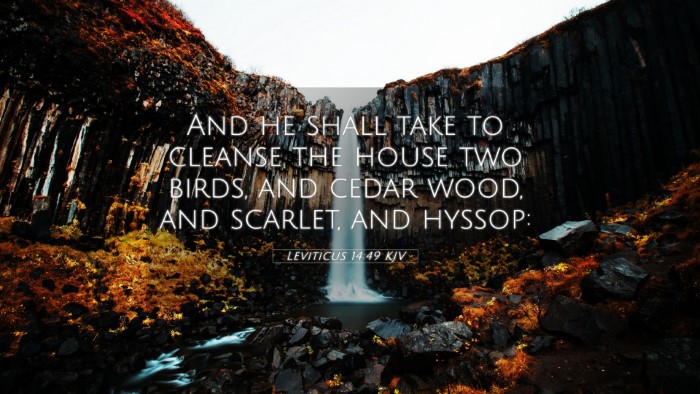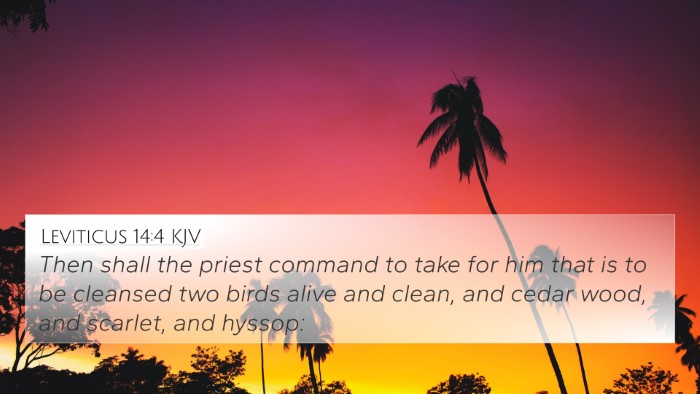Understanding Leviticus 14:49
Bible Verse: Leviticus 14:49 - "And he shall take to cleanse the house two birds, and cedar wood, and scarlet, and hyssop:"
Summary of Biblical Context
Leviticus 14 is part of the laws concerning the leprosy (or skin diseases) and the purification process for both individuals and houses. In this chapter, God provides instructions for the priests on how to identify and respond to leprosy, which could also manifest in a dwelling.
Meaning of Leviticus 14:49
This verse discusses the items required for the cleansing process of a house infected with leprosy. The mention of the two birds signifies a sacrifice that highlights the need for atonement, while the cedar wood, scarlet, and hyssop have symbolic meanings related to purification and restoration.
Commentary Insights
According to Matthew Henry, the process of cleansing the house not only reflects the seriousness of sin (represented by leprosy) but also emphasizes God's mercy in providing a way to restore what was deemed unclean. Each element symbolizes different aspects of purification:
- Two Birds: Represents sacrifice; one is killed and the other symbolizes the release of sin.
- Cedar Wood: Symbolizes strength and longevity, possibly indicating divine protection.
- Scarlet: Often associated with blood and sacrifice, highlighting the seriousness of sin.
- Hyssop: Used in other purification ceremonies (e.g., Exodus 12:22), indicating a cleansing agent.
Albert Barnes adds that the cleansing of the house demonstrates God's holistic approach to purification, addressing both personal and communal spaces. It creates a clear distinction between the sacred and the profane, urging believers to maintain a pure place of worship and living.
Adam Clarke further explains that the rituals involving the birds represent both judgment and forgiveness, capable of restoring not only the individual but also their environment. The repeated reference to birds throughout the Bible may relate to themes of freedom and the Spirit of God.
Connections with Other Bible Verses
Leviticus 14:49 connects with several other scriptures, enriching the understanding of this verse through cross-references:
- Exodus 12:22: The use of hyssop in applying blood during the Passover signifies protection and salvation.
- Psalms 51:7: The desire for purification, with hyssop mentioned as a means to achieve it.
- Hebrews 9:19: References to blood and sprinkled items for cleansing rituals.
- Matthew 8:3: Jesus cleansing the leper, fulfilling the law of purification.
- James 4:8: The call to cleanse oneself, symbolically linking back to the sanctification process.
- 1 Peter 1:2: The theme of being sprinkled by the blood of Christ for spiritual purification.
- Revelation 7:14: Those washed in the blood of the Lamb, emphasizing ultimate cleansing and redemption.
Thematic Bible Verse Connections
The cleansing process outlined in Leviticus highlights recurring themes throughout the Scriptures:
- Purification: Referenced consistently in the sacrificial system (Leviticus 16).
- Restoration: God's consistent call for His people to return and be restored (Joel 2:25).
- Sacrifice: Leading to atonement seen in New Testament theology (Romans 5:8).
Cross-Referencing Biblical Texts
The practice of cross-referencing invites deeper study, supporting Bible verse analysis. Various tools exist to aid in uncovering inter-Biblical dialogue:
- Bible concordance: Identifying keywords and viewing their occurrences throughout the scriptures.
- Bible cross-reference guide: Creating links between related verses for comprehensive study.
- Cross-reference Bible study methods: Structured approaches for systematic exploration of connections.
Conclusion
Leviticus 14:49 may seem to address an ancient practice, yet its themes of purification, atonement, and restoration resonate deeply within the Christian faith today. By understanding the connections between Bible verses and employing cross-referencing tools, believers can gain greater insight into God's Word and His plan for redemption through both the Old and New Testaments.



